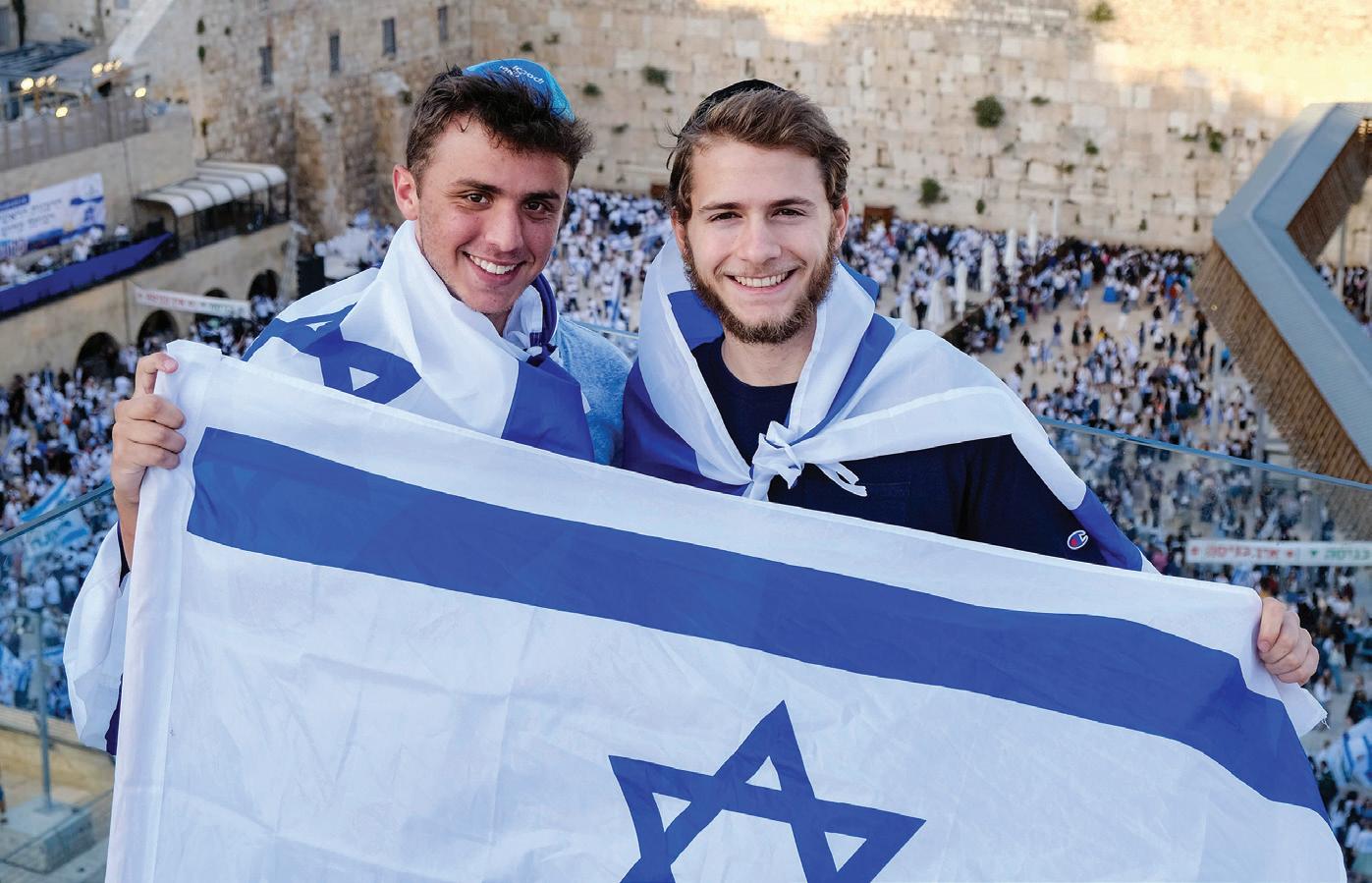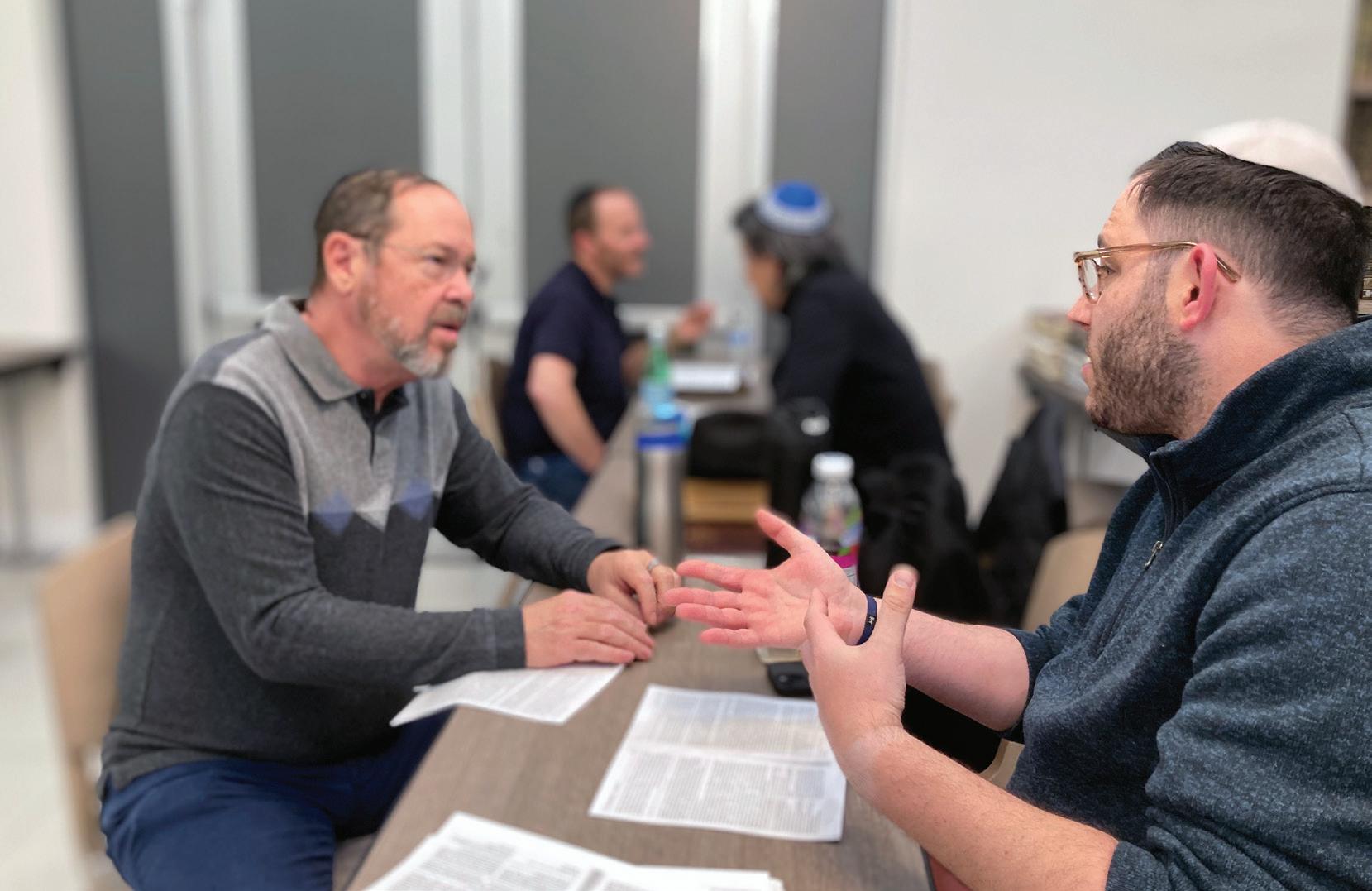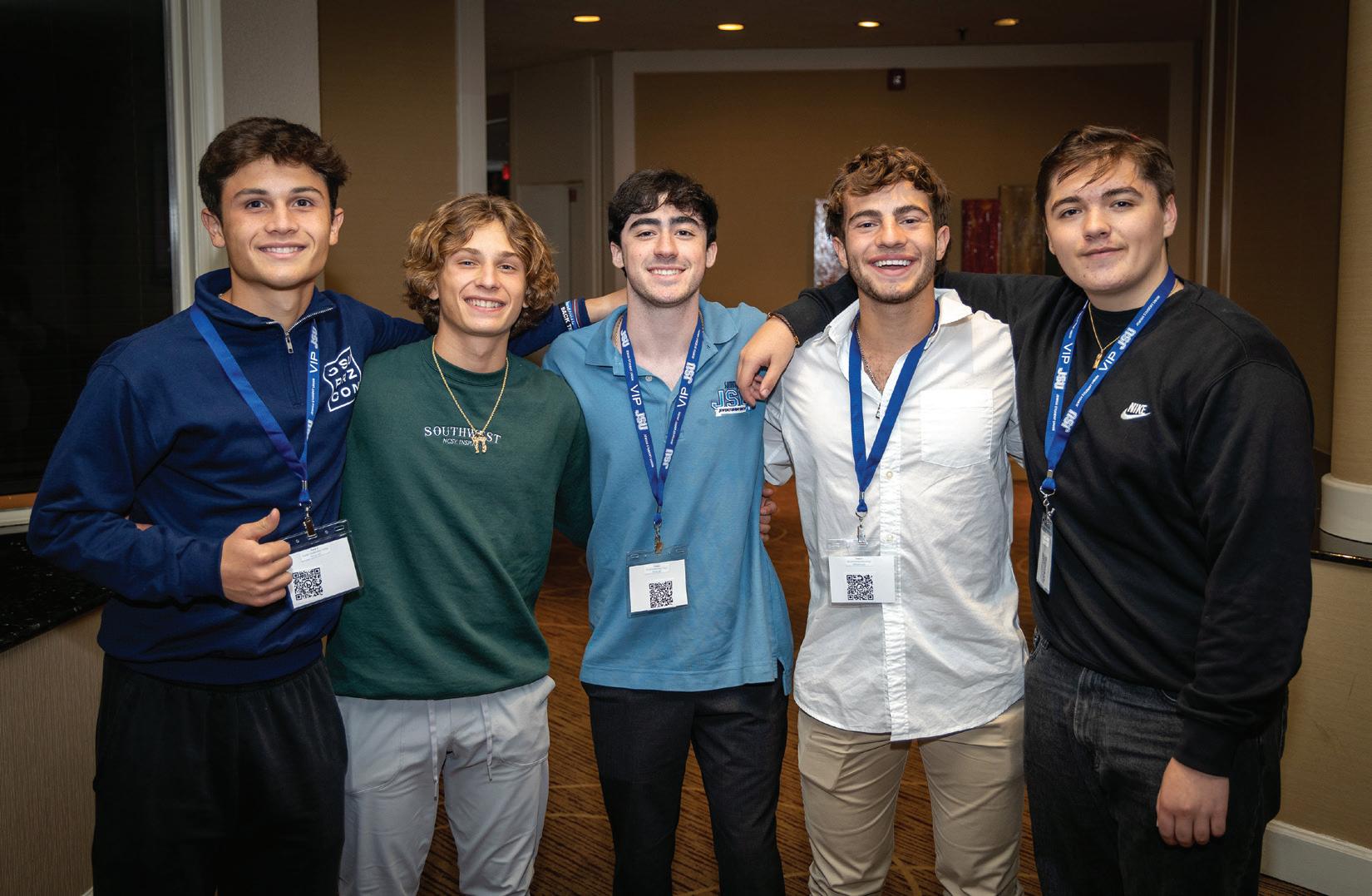



































































































































By Rachel Schwartzberg
Afer her bat mitzvah, Gracie Greenberg, who recently concluded her freshman year at Pace University, fgured she’d had enough of Judaism.
“My feeling was: I’m done! No more Judaism for me,” recalls the Long Island, New York, native.






























































But about a month into her frst semester studying musical theater, everything changed.
“October 7 was a real wake-up call,” she says, recalling her horror at the brazen attack in Israel and the rise in antisemitism that followed—particularly on college campuses like hers. “Being Jewish was part of my identity I hadn’t given much thought to. Why was everyone targeting me?”
As Greenberg was struggling to make sense of the hatred that suddenly surrounded her, she heard about a free dinner at Meor, a national outreach organization with a branch at nearby New York University (NYU). What she found there was overwhelming.
“I discovered a strong community of Jews that included all types,” she says—which she’d never experienced before. Tat dinner set her on a journey to explore Judaism more deeply.







Greenberg never expected that she would travel with Meor to both Poland and Israel in her freshman year of college, but those trips helped her clarify who she is and what’s important to her. It’s been transformative, she says, to discover the role of spirituality and the value of personal responsibility in Judaism.
“I decided I want to marry Jewish,” she says. “I’ve started talking to G-d once a day, and I’ve been taking on small mitzvot. I’ve learned that it’s what I’m doing for Hashem that really matters.”











While Jews the world over have been experiencing a reawakening, this particular article is focused on American Jewry.
October 7 shocked the Jewish world, and the outpouring of anti-Israel and anti-Jewish rhetoric that followed—both on social media and in real life—has sparked a religious awakening among Jews across the US. As counterintuitive as it may seem, the most common Jewish reaction to rising antisemitism has not been laying low and hiding one’s identity, but rather an increase in Torah learning and mitzvah observance and a stronger connection to the Jewish community.
In fact, a recent survey of American Jews by the Jewish Federations of North America noted the “explosion in Jewish belonging and participation,” referring to it as “ Te Surge.” According to the survey, “Of the 83 percent of Jews who were ‘only somewhat,’ ‘not very’ or ‘not at all engaged’ prior to October 7, a whopping 40 percent are now showing up in larger numbers in Jewish life. Tis group—equal to 30 percent of all Jewish adults and nearly double the
proportion of Jews who identify as ‘deeply engaged’—represents the greatest opportunity for broadening and deepening Jewish life” (https:// ejewishphilanthropy.com/what-youneed-to-know-about-the-surge-ofinterest-in-jewish-life/).
Jewish education is benefting as well: 39 percent of Jewish parents indicated they may reevaluate or reconsider educational or summer programs for their children, and 38 percent of parents with kids in a secular private school are considering making the move to Jewish day schools. Among Jews who are not members of synagogues—which according to Pew estimates is 64 percent of US Jews—37 percent say they’d be open to joining one now.
“October 7 lit a fre for Jews around the world,” says Rabbi Mark Wildes, founder of the Manhattan Jewish Experience (MJE). “We’re seeing this real need to learn more about Judaism to make sense of it.”
While Rabbi Wildes has seen a bump in attendance at MJE programs since October 7—MJE’s mission is to engage less afliated Jews in their twenties and thirties in New York—he believes it’s not the numbers that are noteworthy but the eagerness of the participants.
“It’s not hundreds of people coming,” he says. “But there’s a certain urgency among those who are coming. Tey have a need to support Israel, when they previously had, at most, a tenuous connection.”
Rising antisemitism, he says, has “exposed a raw nerve among assimilated American Jews. Tey are suddenly asking, ‘What do I believe in that’s worth defending?’”


American Jews are reaching out—because what they’re actually looking for is “authenticity and connection.” Courtesy of Aish.com
Tis sentiment is echoed across college campuses, as previously unengaged Jewish students struggle to cope with hostility and even outright violence from
Rachel Schwartzberg is a writer and editor who lives with her family in Memphis, Tennessee.
Since October 7, he says, “we went from ‘why be Jewish?’ to ‘how to be Jewish.’”


Courtesy of Aish.com
to be shomer Shabbos,” says Rabbi Aryeh Kaplan, co-director, along with his wife Sharona, of OU-JLIC at University of California-LA (UCLA).
“We’re seeing young men who are deciding to wear a kippah for the frst time on campus.”
pro-Palestinian encampments—and schools unwilling to take a stand to protect their Jewish students. Like Greenberg, Jewish students have been targeted and marginalized, and they feel entirely unequipped to respond to anti-Jewish and anti-Israel accusations.
“Every two or three weeks I meet a student who tells me he’s trying
Te primary mission of OUJLIC is to support Orthodox day school graduates on secular college campuses. “We’re not here to reach out to unafliated Jews,” says Rabbi Kaplan. “But we’re seeing so many students who might have been loosely connected before—people who were on the outskirts of the Orthodox community—who are interested in more.”

“Someone said to me the other day, ‘ Tere’s got to be more to Judaism than bagels and lox if they hate us so much,’” says Rabbi Aaron Eisemann, director of Meor at NYU. “ Tese students want to understand what Judaism is really about.”
While he and his team used to spend signifcant time recruiting kids for programs, those eforts are no longer necessary. “Te encampments recruit them for us,” notes Rabbi Eisemann, who has been working in campus outreach for nearly twenty years. Not only are more kids showing up, but there has been a signifcant growth in the level of content he and his staf are sharing.
“ Tat’s really more telling,” he says. “In the past, the average liberal arts college student questioned the need for Judaism at all; we spent a lot of time on basics. But the campus protests have answered that question for them. Te level of learning we’re doing now is so much higher.”

“October 7 lit a fre for Jews around the world,” says Rabbi Mark Wildes (right), founder of the Manhattan Jewish Experience (MJE). “We’re seeing this real need to learn more about Judaism to make sense of it.” Courtesy of MJE
I’ve been working in the Jewish community for thirty years. I’ve never seen anything like this.

“ Tere’s no way we could ever have gotten Jews to wake up like this,” says Steve Eisenberg, a
successful investment banker turned outreach activist. “It took 1,200 murdered Jews to do this; if we had a billion-dollar budget for outreach, we could not have done this.
“Jews who never did Seders, did Seders this year. Jews who never did Shabbat are trying Shabbat,” says Eisenberg, who serves as the director and co-founder of Jewish International Connection (JIC), a program that “enhances Jewish connection around the world through events and helps strengthen Jewish identity.” “I can’t tell you that the changes are dramatic, but it’s made a large percentage of the Jewish population in America feel more Jewish and identify as Jews. It
cuts deep within the soul of the Jewish people in America.”
“I heard of three Jewish twenty-yearolds who broke up with non-Jewish girlfriends,” he says. “Why? Because, all of a sudden, their non-Jewish girlfriends were siding with Hamas. Te men thought: you are really siding with people who raped and pillaged and murdered babies and burned them alive? Who are you? Another guy told me three people in his family have decided to marry Jews now. Tese are Jews who before October 7 couldn’t care less about intermarrying.”
Since October 7, he says, “we went from ‘why be Jewish?’ to ‘how to be Jewish.’ ”
For your typical unafliated college student, “a rabbi was completely unrelatable,” says Rabbi Eisemann. Tat was before October 7. “But when you can’t go to class because people are yelling at you, the same rabbi is now a safe haven.” Rabbi Eisemann posits that right now young people, especially, are ready for authentic Torah learning because barriers have fallen away.
Grant Ghaemi is a perfect example. A senior at NYU last fall, he found himself very upset afer October 7. “I was disgusted, and I confronted people about their [social media] postings . . . and I lost friends over it,” he recalls. His own reaction surprised him. “ Tere was clearly something about what happened on October 7 that changed me,” he says. Before, he had prided himself on not letting political views get in the way of relationships.
A few weeks later, he met Rabbi Eisemann in front of the NYU library. “With a big smile,” says Ghaemi, “he stretched out his hand and asked, ‘Are you a Jew?’ Up until then, when someone asked me that, I’d say no or keep walking. But this time I thought to myself, if there’s ever a time to
embrace this, the time is now. So I shook his hand and said, ‘Yes I am.’”
Ghaemi grew up in a “very secular household” in New Jersey; his father was raised in a Muslim family in Tehran. “As a kid, my family celebrated Chanukah, a version of Rosh Hashanah, and Yom Kippur when my mother remembered,” he says. “And also Christmas and Easter and Eid.”
In his last semester at NYU, Ghaemi committed to learning at Meor at least once a week, and he attended his frst Shabbaton in Passaic, New Jersey.
He admits he “felt terribly out of place” at frst when he arrived at his hosts’ home. “I had preconceptions about Orthodox Jews,” he says. “I didn’t know any Hebrew. I didn’t even know what Shabbat was.” However, he was quickly blown away by the warm welcome he received—“from literal strangers.”
“I was shocked to fnd an entire community that viewed me as part of their extended family,” he says. Ghaemi ended up becoming a regular on Shabbatons, and even brought his mom along to get a taste of Shabbat, too. Afer graduating in the spring, he began working remotely so he could participate in a six-week Meor fellowship in Lakewood, New Jersey.
Tis “reawakening” spans all demographics and geography.
Rabbi Josh Broide, director of the Center for Jewish Engagement (CJE), a division of the Jewish Federation of South Palm Beach County, and outreach rabbi at Boca Raton Synagogue in Florida, says he ran an Israel-oriented program soon afer October 7 and expected a dozen people. More than 100 showed up. Even months afer October 7, program attendance remains signifcantly higher than in the past. “Of course you’d get people [at previous programs], but nothing in the numbers like this,” he says. “And the people who would show up were the people you’d expect to show up. But now we are getting people we would never expect to show up.”
Moreover, since the Hamas attack, afer any Israel-centered talk or presentation, he has come to expect a long line of people waiting to speak to him. “Tey say things like, ‘Rabbi, I’m so happy to be here. What else can I do to get involved?’
‘Rabbi, Israel is the most important thing on my


In the days and weeks immediately following October 7, there was a marked increase in participation in both the Community Kollel of Greater Las Vegas’s outreach programs and its regular minyanim and shiurim. Courtesy of Rabbi Nachum Meth

mind.’ I’ve been working in the Jewish community for thirty years. I’ve never seen anything like this.”
Tis scenario is playing out all over the outreach world. “We’ve had triple the number of people engaging with us,” says Rabbi Tzvi Broker, one of the humans behind the Live chat feature on Aish.com. For about ten hours a day, six days a week, he or a member of his team mans the chat. Since October 7, the platform has seen more than 5,000 people reaching out each month.
Loren (not her real name) is intermarried and living in New Hampshire, and she recently reached out via the live chat. “Decades afer my attempt to raise my three children Jewish, I am fnally taking the time to focus on my faith,” she wrote. “I’m blown away by the utter courage, strength and historical greatness of the State of Israel and the Jewish people. October 7, for some strange reason, was shocking and paralyzing for me. Since then I have joined the nearby Chabad and latched on to a few more resources for learning.”
Rabbi Broker had a lengthy online conversation with her about how to actualize her newfound

High school senior Noah Simon (frst on the right) has found a supportive community in the JSU club at his public school in Plano, Texas. Following October 7, Noah began wearing tzitzit and a kippah to his public school every day. Seen here, Noah at the JSU Presidents Conference this past November.
passion. She hopes to visit Israel soon.
“A few things have become clear over the past several months,” says Rabbi Broker. “Every Jewish heart was torn on October 7. And the fact that the non-Jewish response didn’t validate that feeling at all made people feel very, very alone. All of a sudden, they felt out of place in their own lives. Tey needed to talk to us.”
He adds that if people just wanted to know more about Judaism, they could fnd ample information online. But Jewish people are reaching out— because what they’re actually looking for is “authenticity and connection.”
“ Tere are Jews in Jewish communities right now who are hungry. Tey want to connect,” says Rabbi Broide.
For teens who are looking to connect with Jewish peers, NCSY runs JSU clubs in public and private (nonJewish) high schools across the US and Canada. JSU has also seen a huge uptick in the number of teens reaching out to open clubs at their schools this year, says Devora Simon, national director of JSU.
“In the past, we received about one online request per month to start a JSU club,” she says. “ Tis year alone we received 120 requests—ninety of them have resulted in the creation of
active clubs. Along with the requests, she says, “about 98 percent of the time, the teens write some version of, ‘Since October 7, I’ve experienced antisemitism and I want to learn more about my heritage.’ Or, ‘I want to come closer to the Jewish community.’”
JSU reached approximately 18,500 Jewish teens last year, 4,000 more teens than the previous year. And not only did more teens show up, Simon adds, but “teens are more engaged than ever, with average attendance per club higher than ever.”
Simon recognizes that the increase in numbers may refect teens’ interest in connecting with other Jews, but she feels that the sense of belonging is a signifcant factor. “Community has always drawn people,” she says. “ Te social aspect is especially critical.”
At the same time, she notes that JSU programs across the country saw a 20 percent increase in the number of teens attending programs outside of school. “We call these ‘higher-level programs.’ Tey are more content and educational oriented,” she explains. For example, a steady group of teens in Baltimore attend a weekly Mesillat Yesharim chaburah at 7 am, waking up early to make the class before heading to their nearby public high school. “ Tat’s a serious commitment,” she notes.



One teen who fnds a supportive community in JSU is Noah Simon. With about ffy Jewish students out of 1,500 in his public school in Plano, Texas, a suburb of Dallas, Noah enjoys the sense of community JSU provides. Meeting during lunch period every other week, the JSU club in his school provides him with “a Jewish environment” and a place where he “can talk with like-minded people and make friends.”
Since October 7, Noah has been wearing tzitzit and a kippah to school. Te senior, who serves as co-president of the JSU at his school, was growing religiously even before the Hamas attack. But October 7 empowered Noah, a sof-spoken sensitive young man, even more, and he began keeping kosher. “I started to not go out for lunch with friends,” he says. “I have defnitely grown a lot.”
Following October 7, this “awakening” was evident among Orthodox Jews as well. While less afliated Jews may have been connecting with the Jewish community for the frst time, Orthodox Jews were pouring into shuls, tefllah gatherings, Tehillim groups and other programs across the country.
“October 7 was traumatic for all of us,” says Rabbi Nachum Meth, executive director and rosh kollel at the Community Kollel of Greater Las Vegas, which serves as a hub for dynamic programs for Jews of all ages, backgrounds and levels of observance. “People felt motivated to go somewhere and do something.” As a result, there was a marked increase in participation in both the Kollel’s outreach programs and its regular minyanim and shiurim. “ Tere were defnitely more frum people coming to shul on Shabbos,” he says. “However, as the acuteness of the situation waned, participation dropped back to normal. Tat’s simply human nature.”
Te big question on the minds of outreach professionals and informal educators is whether the post–October 7 religious awakening will have staying power or not. And it might be too soon to know.
Rabbi Kaplan is hopeful that “people who have made real changes in their lives will stick with them.” However, he points out that sometimes, though signs of outward growth may not all be sustained, people’s experiences now can still have a long-term efect. “For example, maybe these students will make a commitment to send their kids to Jewish schools when the time comes,” he notes.
Overall, however, he believes that this moment in time will have a deep and lasting impact on the Jewish community. “People who are taking on more religious observance have been welcomed with open arms,” he says. “ Tat experience will stick with them for life.”
Although Ghaemi doesn’t know where his journey will take him now that he has graduated college and is working full-time, “the amount I’ve learned about my values and grown as a person has been remarkable,” he says. “Judaism has taught me to seek to be better every day and has given me concrete ways to do that. Until I met Orthodox Jews, I had never known the concept of devotion and sacrifce for higher ideals. I’ve seen the beauty of Shabbos, and families coming together to connect. I want to take that into my life.”
“I can’t say what the future will hold,” says college student Gracie Greenberg, in terms of her religious observance. “Right now, I’m lighting Shabbos candles and saying Kiddush. I would like to continue doing those things, and I plan to keep learning and growing.”
For Jews like Ghaemi and Greenberg, there’s no going back to their pre–October 7 selves.
Courtesy of Aish.com






In the feld of Jewish outreach, there hasn’t been a receptive environment like this since the Six-Day War.
Tat’s a refrain heard among outreach professionals.
“October 7 awakened the sleeping giant,” says Rabbi Aaron Eisemann, director of Meor at NYU.
“It’s an amazing opportunity, and we have to be there for our fellow Jews.”
Kiruv professionals—working with all demographics—stress that they cannot single-handedly reach the many unafliated Jews across the country who are searching for connection in the post–October 7 world. It’s time for all hands on deck.
“To come closer to Torah, people need real relationships—and these all take a tremendous amount of time,” says Rabbi Eisemann. “Rabbis on campuses are desperate for help. Call your local campus rabbi and ofer to host or mentor a student,” he suggests. Frum professionals and entrepreneurs, especially, can play an important role acting as mentors for college students who are focused on launching their careers.







By Rachel Schwartzberg

“Kiruv happens one neshamah at a time,” says Rabbi Zev Kahn, director of Jewish Education Team (JET) based in Chicago. “A person can, on average, have relationships with about eighty people at one time. When you have 5,000 students on a campus, for example, even if 4,500 of them are not interested, one person can’t have a relationship with the 500 who are interested.”
Te bottom line: Outreach cannot be limited to the professionals.
Tis doesn’t mean, says Rabbi Josh Broide, director of the Center for Jewish Engagement (CJE), a division of the Jewish Federation of South Palm Beach County, and outreach rabbi at Boca Raton Synagogue in Florida, that you, as a frum Jew, need to get training as an outreach professional. What it does mean, however, is that you need to pay attention to the opportunities sent your way. “You need to say to yourself: ‘Hakadosh Baruch Hu sent this one person that I just happened to interact with, and I’m going to take responsibility for that person.”’
“I once got a call from someone who lived in a Chicago suburb about an hour and a half away from where
I live,” says Rabbi Kahn. “He said, ‘Rabbi, there’s a guy who works in a cubicle next to me. He’s Jewish and he’s really interested in learning. Would you be willing to drive up and come and learn with him?’ I said to him, ‘You know what? I have a much better idea. Why don’t you learn with him?’ He replied: ‘What, me?! How can I learn with this guy?’”
Many Orthodox Jews are afraid of engaging with Jews who are beginning their religious journeys, says Rabbi Kahn. Tey are worried: What if a beginner asks a question they can’t answer? Rabbi Kahn’s response: “You don’t need to have all the answers. You need to have ahavas Yisrael.”
“If we really believed in what we’re doing and the life we’re living, we’d want to share that with every Jew,” says Steve Eisenberg, co-founder of Jewish International Connection (JIC).
“Jews in the US are much more connected Jewishly today than they were on October 6,” he says. It’s a perfect opportunity for frum people to invite fellow Jews to their Shabbos meals or to their sukkahs, for example. “If every observant Jew would invite one
Jew a month,” he says, “you could have between 15,000 and 20,000 Jews each month experiencing a Shabbos meal.”
But Eisenberg is not optimistic about the majority of the Orthodox community stepping up to the plate. “Where is the Orthodox community?” he asks.
Unfortunately, he says, some in the Orthodox community prefer to focus inward. “We say to ourselves, ‘It’s enough that my kids go to yeshivah and I’m keeping the Torah . . . Hashem will take care of me.’ But we’re not taking achrayus for the generation.”
Some kiruv professionals posit that the Modern Orthodox community is uniquely situated to engage in outreach.
“ Te Modern Orthodox community is no diferent professionally in many ways than many of the unafliated Jews we’re looking to attract. We’re also doctors. We’re also orthodontists. Te guy you would be learning with looks just like you,” says Rabbi Broide.
“It’s a much easier shif for someone to envision themselves coming closer to Judaism when it seems to be doable within their comfort zone,” says Rabbi Aryeh Kaplan, co-director of OU-JLIC at University of California-LA (UCLA).
“ Tey can say, ‘I see my colleague or classmate doing this; maybe I can do it, too.’”
Rabbi Kaplan believes it would go a long way if Orthodox students proactively reached out to other Jewish students and created a welcoming atmosphere on college campuses.
“Your typical Orthodox teen from Pico Robertson in Los Angeles, or Teaneck, New Jersey, doesn’t know nonobservant kids,” he says. “Everyone is Orthodox around them. But in college, this is their moment—now they’re meeting [non-Orthodox Jews].”
A simple way anyone can help spread Torah to less afliated Jews is by contributing fnancially to
outreach programs. Without fnancial backing, even the most idealistic kiruv professionals cannot reach the many Jews who are looking for a connection to Judaism.
For example, NCSY’s JSU program for public high school students reaches thousands of teens each year. But according to Devora Simon, national director of JSU, there are roughly 350,000 Jewish kids in non-Jewish high schools in North America. “Based on the soaring interest in JSU programming, we know we can be reaching exponentially more teens,” says Simon.
JSU has seen a huge spike in the number of requests for new clubs since October 7, and JSU has tried to accommodate as many teens as possible. Unfortunately, stafng remains a huge obstacle. “I’m getting requests from places like Nashville, Vermont and Salt Lake City,” she says. “It’s hard to get people to move to more remote places. We are building out a robust system and platform to engage teens remotely, and empower them to lead in their communities, but we need the infrastructure and staf to support the program and manage these relationships.”
Many outreach professionals feel that in the post–October 7 world, the Orthodox community must prioritize Jewish outreach when allocating tzedakah funds. “It’s heartbreaking what teens are dealing with in school every day,” says Simon. “ Tese are young people in ofen hostile or unwelcoming environments who need us to be there for them. We simply need the resources to take care of these Jewish teens.”
to spread positive messages and have an impact on a wider network.
“If the bad news on social media is all people are seeing, it’s depressing,” notes Rabbi Mark Wildes, founder of Manhattan Jewish Experience (MJE). “So let’s not talk about why people hate us. Let’s highlight what’s positive.” He suggests providing a counterbalance in people’s feeds—showing all the good things that are part of the Jewish community—for example, Shabbat, trips to Israel, the remarkable chesed that takes place. “Our job needs to be bringing light into the world.”
Well before October 7, communal organizations like the OU and others have been making sure there is infrastructure in place to serve Jews across the country, says Rabbi Kaplan. Because of that, he says, young Jews who are searching for community
Rachel Schwartzberg is a writer and editor who lives with her family in Memphis, Tennessee.
Aside from providing fnancial support, individuals can act as ambassadors on behalf of Torah Judaism. Social

People are looking.
What are our communities doing to open those doors to the greater Jewish community?
have an address to turn to. “Whether it’s NCSY or OU-JLIC, we are where young American Jews are,” he says. As a result, “there are many more opportunities, because we’re already here to facilitate. If people are ready to jump, we’re ready to catch them.”
But despite all the kiruv programs and initiatives, more needs to be done on the communal level. Every shul, in fact, has a role to play, say experts. “People are looking. What are our communities doing to open those doors to the greater Jewish community?” asks Rabbi Broide. Every shul, he maintains, should have at least one outreach program. And while the programs might be diferent for each shul, depending on the population, he believes the core ingredients have to be there. “It has to be warm and welcoming,” he says. “We have something real. We have something special. What are we doing
to invite the broader community to be part of it?”
Shuls can help promote programs such as Partners in Torah, a highly successful initiative where participants get to study one on one over the phone or on Zoom with a mentor chosen especially for them. In Boca Raton, Rabbi Broide oversees a diferent initiative called Partners in Jewish Life. Instead of being over the phone or via Zoom, partners meet in a large space where they study prepared sources focused on the popular teachings of Rabbi Jonathan Sacks. Te curriculum, currently used in six shuls around the country with many more interested, resonates strongly with Jews from all backgrounds.
“ Tis program might not have worked a few years ago because people were in their own lanes—it’s my shul, it’s my Federation, it’s my JCC,” says Rabbi Broide. “But since October 7
Jews are looking to connect to the larger Jewish community.”
Now that the interest is burgeoning, kiruv professionals are asking difcult questions: If Jewish kids want to attend an Orthodox Jewish day school, can we accommodate them? If Jewish families want to start attending an Orthodox synagogue, are our shuls welcoming enough?

“No Jew lef behind—every single Jew should have an opportunity to interact with Jews who are a part of the formal Jewish community,” says Rabbi Broide.
Te central question Rabbi Broide and many others in the kiruv world are asking is: Are we—the Orthodox community—prepared for this?
